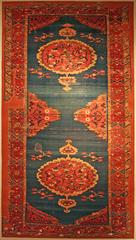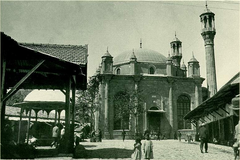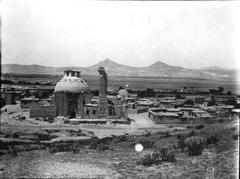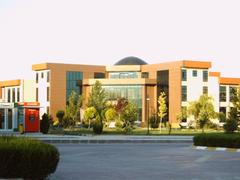Karatay Madrasah: Visiting Hours, Tickets, and Historical Guide – Konya, Turkey
Date: 14/06/2025
Introduction
Located in the heart of Konya, Turkey, the Karatay Madrasah is a masterwork of Anatolian Seljuk architecture and a vital monument in the region’s cultural and spiritual history. Commissioned by Emir Celaleddin Karatay and completed in 1251 CE under Sultan Izzettin Keykavus II, this former center of Islamic learning is celebrated for its domed courtyard, elaborately carved marble portal, and dazzling Seljuk tilework (Turkish Museums; wowcappadocia.com). Since 1955, it has served as the Karatay Tile Works Museum, housing a remarkable collection of Seljuk and Ottoman ceramics. This guide provides a comprehensive overview of its history, architectural highlights, cultural significance, practical visiting information, and travel tips to ensure a rewarding exploration of one of Konya’s most treasured sites.
Contents
- Overview and Historical Context
- Architectural Features and Artistic Heritage
- Spiritual Significance and Sufi Connections
- Museum Transformation and Conservation
- Visiting Information
- Hours & Tickets
- Accessibility
- Directions
- Best Visiting Times
- Nearby Attractions
- Guided Tours & Events
- Photography Tips
- Influence on Local Culture and Contemporary Konya
- Frequently Asked Questions (FAQ)
- Conclusion and Recommendations
- Sources & Further Reading
Overview and Historical Context
Karatay Madrasah was established as a distinguished center of Islamic learning in 1251, symbolizing the intellectual and spiritual vibrancy of Seljuk Konya (TravelSetu). The city, then the Seljuk capital, was a renowned hub for scholarship, philosophy, and Sufi mysticism. The madrasa’s founding by Emir Celaleddin Karatay, a leading statesman and patron of education, reflects the era’s commitment to intertwining religious studies with science and the arts (FlyPGS).
Architectural Features and Artistic Heritage
Karatay Madrasah’s design is a singular example of the “closed courtyard” style, with a central space covered by a grand dome—a rare innovation among Anatolian madrasas. The eastern entrance is marked by a monumental marble portal, intricately adorned with geometric and floral reliefs, Qur’anic verses, and hadiths (Turkish Museums). The interior is renowned for its Seljuk tilework: turquoise, cobalt blue, and black mosaics form complex arabesques and calligraphic bands, representing cosmological themes and spiritual ideals.
Original features such as the dome’s pendentives, the water fountain (şadırvan) in the courtyard, and the arrangement of classrooms and cells around the central hall exemplify Seljuk engineering and artistry. The tomb of Celaleddin Karatay, located in a domed chamber, further enhances the site’s spiritual resonance.
Spiritual Significance and Sufi Connections
Karatay Madrasah’s proximity to the Mevlana Museum, the mausoleum of Rumi, situates it within Konya’s wider Sufi landscape (erikastravels.com). During its educational prime, the madrasa’s curriculum integrated Sufi metaphysics, poetry, and ethics into religious and scientific studies. Tile inscriptions and invocation panels above doorways, featuring names of prophets and Qur’anic verses like Ayet-el Kürsi, reflect the universalist themes of Sufi thought (wowcappadocia.com).
The design encourages contemplation and spiritual discipline, with the domed hall and serene courtyard serving as spaces for both study and reflection.
Museum Transformation and Conservation
By the late 19th century, changing educational practices led to the madrasa’s abandonment. In 1955, it was repurposed as the Karatay Tile Works Museum, preserving Seljuk and Ottoman ceramics, tiles, and glassware (TravelSetu). Restoration projects, most recently between 2006 and 2008, have ensured the survival of its architectural and artistic treasures (Turkish Museums).
The museum’s collection includes spectacular examples of tilework from Kubadabad Palace, Seljuk ceramics, unglazed pottery, and Sufi-inspired motifs, displayed in their original architectural context (whichmuseum.com).
Visiting Information
Hours & Tickets
- Opening Hours: Open Tuesday to Sunday, 08:30–12:30 and 13:30–17:30. Closed Mondays. Always confirm times before your visit, as these may vary on holidays (whichmuseum.com).
- Admission: General entry is approximately 15–25 Turkish Lira, with discounts for students, seniors, and groups. Tickets are available at the entrance; Museum Pass Turkey or Museum Pass Konya may offer further savings.
Accessibility
- Mobility: The main hall is accessible, but some areas may present challenges due to the historic structure. Ramps are present, and staff assistance is available upon request.
- Facilities: Restrooms and a gift shop are on site.
Directions
- Location: Ferhuniye Neighborhood, Adliye Boulevard, Karatay district, Konya. Walking distance from Alaettin Mosque and Mevlana Museum; accessible via city buses and taxis.
- Parking: Nearby public parking is available.
Best Visiting Times
- Seasons: Spring and autumn offer mild weather and fewer crowds.
- Day/Time: Morning hours and weekdays are best for a quieter visit and optimal lighting for photography.
Nearby Attractions
- Mevlana Museum: The spiritual heart of Konya and Sufism.
- Alaettin Mosque: One of Anatolia’s oldest mosques.
- Ince Minaret Medrese: Renowned for its minaret and stone carvings.
- Sirçali Medrese: Notable for Seljuk tilework.
Guided Tours & Special Events
- Tours: Guided tours in multiple languages can be booked on-site or through local agencies, offering deeper historical context.
- Events: The museum occasionally holds special exhibitions and workshops; check ahead for schedules.
Photography Tips
- Non-flash photography is permitted in most areas. The marble portal, domed courtyard, and tilework mosaics are especially photogenic.
Influence on Local Culture and Contemporary Konya
The legacy of Karatay Madrasah is deeply woven into Konya’s traditions of tile making, calligraphy, and Sufi music. Its motifs inspire local artisans, while its preservation supports intercultural dialogue and spiritual tourism. The Whirling Dervish ceremonies at the nearby Mevlana Cultural Center draw thousands, further highlighting the enduring cultural resonance of the madrasa (erikastravels.com; exploremoreturkey.com).
Frequently Asked Questions (FAQ)
Q: What are the current visiting hours?
A: Open Tuesday to Sunday, 08:30–12:30 and 13:30–17:30; closed Mondays.
Q: How much is the entry fee?
A: Around 15–25 Turkish Lira for adults, with discounts available.
Q: Is Karatay Madrasah wheelchair accessible?
A: The main hall is accessible; some areas may be challenging for those with limited mobility.
Q: Are guided tours available?
A: Yes, they can be booked on-site or through local agencies.
Q: Can I take photos inside?
A: Non-flash photography is generally allowed; always respect posted rules.
Conclusion and Recommendations
Karatay Madrasah is a unique destination where history, art, and spirituality converge. Its architectural innovations, stunning tilework, and role as both a center of learning and a museum make it a highlight of any visit to Konya. With accessible hours, affordable tickets, and proximity to other key sites like the Mevlana Museum, it is ideal for those seeking to experience the depth of Seljuk and Sufi heritage. For a richer experience, consider a guided tour or plan your visit during a cultural event.
Download the Audiala app for real-time updates, interactive tours, and more travel resources. For further planning, explore official tourism sites and related articles on Konya’s historical treasures.
Sources and Further Reading
- Turkish Museums - Karatay Tile Works Museum
- TravelSetu - Karatay Madrasa Tourism History
- wowcappadocia.com - Karatay Madrasah Konya
- erikastravels.com - Konya Turkey Whirling Dervishes
- whichmuseum.com - Karatay Madrasah Konya
- FlyPGS - Everything You Need to Know About Konya
- exploremoreturkey.com - The Historical and Spiritual Significance of the Mevlana Museum in Konya
- investinkonya.gov.tr - Konya Culture and Tourism



